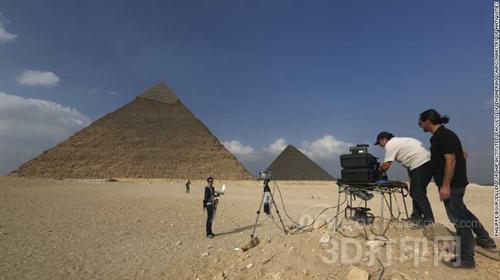The Egyptian pyramid, one of the wonders of the four civilizations, attracts the attention of thousands of researchers. Even the ordinary people, through the information written in books such as the world's unsolved mystery, are still infinitely curious. There is something in the pyramid, how it was built. These questions have not been answered so far, but people will not give up research. This month, the research project called Scan Pyramids, which was carried out using 3D scanning and printing technology, is in full swing.

The Scan Pyramids project, which was carried out by the Egyptian Ministry of History and Culture, was jointly carried out in cooperation with the Engineering Department of Cairo University and the French HIP Research Institute. It was officially launched in November this year. Cairo University, Laval University in Quebec, and Nagoya University in Japan will all participate in a series of sophisticated cutting-edge technologies, including 3D scanning, to explore the interior of the pyramid and try to unravel the mystery of the world.
The study focused on four pyramids, the North-South Pyramid (also known as the Curved Pyramid and the Red Pyramid) in the Dashur area, and the Khufu Pyramid and the Hafra Pyramid on the Giza Plateau. This will not be a simple and quick attempt, and the research project is expected to be completed by the end of 2016. The initial scan will use infrared thermal imaging to create a pyramid heat map to reveal the different densities of the internal structure. The second and subsequent deeper scans will take a year to complete, conducted by Laval University, trying to identify if there are any voids or hollow spaces behind the pyramid wall.

Later, Nagoya University and Japan's KEK research team will use the muon probe to further distinguish these solid and hollow spaces. The muon is a negatively charged, 206.6-fold composite particle with a mass of 206,000 times. It consists of a quark and an antiquark. The interaction force acts as a hadron. The detector placed at a specific location measures the cumulative muons in the pyramid, and the researchers can see in which solid areas the particles are absorbed or deflected, and the hollow areas are not subject to any interference.
The French company Iconem will use drones for 3D photographic mapping. The scanning range covers the entire Dashur and Giza Plateau areas. There are two types of drones. The area is scanned in different sizes and finally created to the nearest centimeter. Detailed landscape 3D model.
The first type of drone has wings, just like airplanes, researchers can get large areas of data through them, and the other smaller drone is mainly responsible for scanning close-up pictures of pyramid walls, which can be seen from Information such as materials, alignments, and traces left by tools during construction. Finally, the laser scanner will be used to scan the internal structure of the pyramid. The 3D model of these scan results will be handled by the HIP Institute and will be made public.
During the two weeks of the project, some “thermal anomalies†inside the pyramid have been discovered, indicating that there may be caves and hollow areas in the pyramid. Further detailed data will be discovered one after another, but the research team will send the data directly to the relevant Egyptian scientist. How will the project develop and what results will be achieved, we will continue to pay attention.
Dog Treat Pouch,Pet Treat Pouch,Cat Treat Pouch,Leather Dog Treat Pouch
China Movepeak Pet Supplies Co.,LTD. , https://www.pet-supplies-factory.com